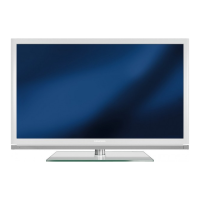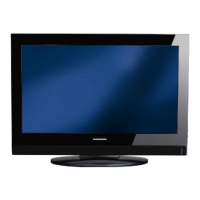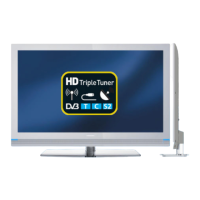ENGLISH
2
CONTENTS
-------------------------------------------------------------------------------------------------------------------------------------
4 SETUP AND SAFETY
6 GENERAL INFORMATION
6 Special features of your television set
7 Receiving digital channels
7 Important notes on environmental
protection
7 Notes on still images
8 CONNECTION AND PREPARATION
8 Connecting the antenna and power cord
9 Inserting batteries into the remote control
10 OVERVIEW
10 Connections on the television set
11 Controls on the television set
12 The remote control – Main functions
13 The remote control –
All functions
14 SETTINGS
14 Initial set-up and tuning television
channels
14 Selecting language, country and
operating mode
15 Tuning the television channels from
satellite (DVB-S)
17 Tuning terrestrial television channels
(DVB-T)
17 Tuning television channels from the cable
provider (DVB-C)
18 Changing the program table for the
digital channels
21 Picture settings
22 Sound settings
24 TELEVISION - OPERATION
24 Basic functions
25 Zoom function
25 Eco mode
26 Zapping function
26 Electronic TV guide
27 Changing the picture format
28 3D FUNCTION
28 Important information about the 3D
function
28 Preparing the 3D function
29 3D Settings
31 SMART INTER@CTIVE TV AND
HOME NETWORK
31 What is Smart Inter@ctive TV
31 Network connection
31 Wired network
37 Smart Inter@ctive TV internet applications
39 Playback the video, music and image files
with home network connection
40 vTuner internet radio
41 USB RECORDING
41 Information on recording and playing
television programmes
41 Possible limitations when using an
external data medium
42 Connecting external data media
42 Settings for USB recording
44 ″Pausing” time shift programmes
44 Recording programmes
45 Presetting programmes to be recorded
47 Playback
47 Deleting programmes in the recording list
48 USB OPERATION
48 File formats
49 Connecting external
data media
50 The file browser
50 Settings in the USB setup menu
51 Basic playback functions
52 Additional playback
functions
54 TELETEXT OPERATION
54 TOP text or FLOF text mode
54 Additional functions
55 INTERACTIVE PORTAL (HBBTV)
55 What is HbbTV?
55 Additional functions for video sequences
56 CONVENIENCE FUNCTIONS
56 Opening the SETTINGS menu
56 Language settings
57 Setting the date and time
57 Timer settings
58 Parental control settings
59 Updating software (OAD)
59 Updating software (Online)
59 Restoring the television to the default settings




